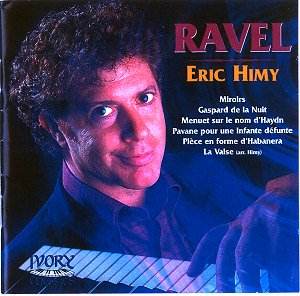Thereís far too much wrong with these Miroirs. On the
first line of Noctuelles Ravel has two separate phrases, each starting
pianissimo and making a crescendo; we just get a confused mass of notes
in a single crescendo. Then the rest at the bottom of the page is pedalled
through so we perceive only one single arpeggio instead of first one,
then a little hesitation, then another. All this and so much more is
beautifully clear in Cécile Oussetís Eterna recording (Berlin
Classics 0032252BC) which I reviewed recently and I think in retrospect
that I didnít praise her classically French virtues half enough. Nor
does she blur the second bar of Oiseaux tristes with pedal as Himy does
(so he finds himself twice sitting on a second inversion chord that
Ravel never wrote). The notoriously difficult repeated note passage
in Alborada del Gracioso sounds confused; from Ousset it is crystal
clear. Nitpicking points, you may think, but when there are five or
six of them per page it hardly seems worth going on; I canít recommend
this.
The first two pieces of Gaspard go much better (has
he had it in his repertoire longer?) and are attractively done. But
in Scarbo the effort is too plain. And in the pianissimo passage against
shimmering octaves (p. 26 if you have a Durand score handy) he is nowhere
near pianissimo, horribly near forte in fact. Ousset is excellent again
here.
It hardly saves the day at this point that the Pièce
en forme de Habanera is atmospherically realised, the Pavane is sensitively
done (except for a heavy opening) and I really liked the Menuet. Slightly
more leisurely than usual, this performance finds more in the music
than many.
Himy has made his own adaptation of La Valse, incorporating
more of the colouristic orchestral details than Ravel himself did. This
cuts no ice with me when I hear what is apparently a bar by bar struggle
to get through it which leaves no time for elegance or grace and which
gives no idea of the scoreís steady build-up. It was a pleasure to hear
again Francesco Libettaís version (VAI VAIA 1196) which recreates much
of the style of the best orchestral versions.
Himy gets a fine recording and writes good notes, though
he is misinformed when he says Alborada derives its name from the French
aube and the Italian alba. Alborada is simply the
Spanish translation of the French word aubade.
This is a short review by my standards but this is
a case where the less said the better.
Christopher Howell
